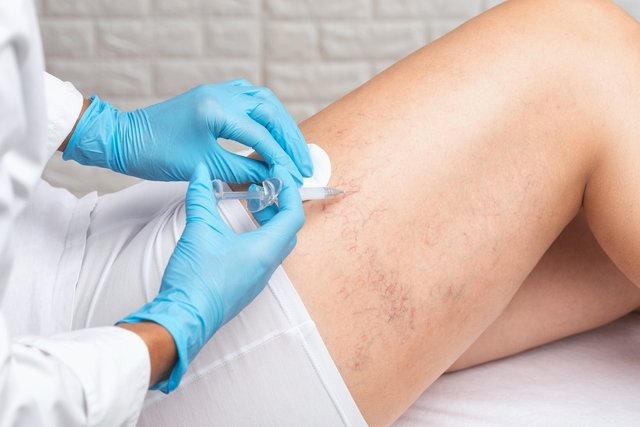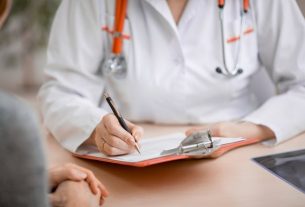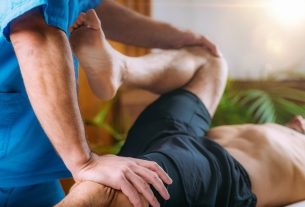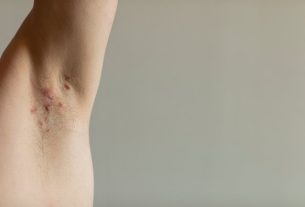Sclerotherapy is a treatment for varicose veins and spider veins in the legs, carried out by applying foam or glucose injection, or using a laser, which favors the redirection of blood circulation, promoting the elimination of varicose veins or spider veins.
This type of treatment is carried out by a dermatologist or angiologist for aesthetic purposes, to improve the appearance of the skin on the legs with spider veins, or when symptoms of varicose veins such as leg pain, swelling or night cramps are present, for example. See other symptoms of varicose veins.
After treatment with sclerotherapy, the treated vein tends to disappear over a few weeks and, therefore, it may take up to a month to see the final result. This treatment can also be used in other cases of dilated veins, such as hemorrhoids or hydrocele, for example, although it is rarer.

When is indicated
Sclerotherapy is indicated in the following situations:
- All cases of spider veins and varicose veins;
- Varicose veins or varicose veins that cause symptoms;
- Aesthetic discomfort with spider veins on the legs.
Sclerotherapy is a type of invasive treatment, and should only be done when other methods, such as the use of elastic stockings, fail to reduce varicose veins.
However, as the veins become very dilated, blood flow slows down, which can lead to the formation of clots and, subsequently, thrombosis, which is why treatment with sclerotherapy may be recommended by the doctor to reduce health risks. .
Ideally, the person undergoing sclerotherapy should not be overweight, as this will ensure better healing and the appearance of other spider veins.
Taking care of your health has never been easier!
Types of sclerotherapy
The main types of sclerotherapy are:
1. Glucose sclerotherapy
Glucose sclerotherapy, also known as injection sclerotherapy, is performed by applying an injection directly into varicose veins or microvarices of up to 2 mm, containing a concentrated glucose solution, generally 50% or 75%.
Glucose sclerotherapy is a type of treatment carried out by an angiologist that consists of applying glucose directly to varicose veins or microvarices up to 2 mm in diameter, as it causes irritation and inflammation of the vessel, resulting in scars that end up closing it.
Glucose sclerotherapy is not recommended for diabetic people, as it can interfere with blood sugar levels. Understand better how glucose sclerotherapy works and the possible side effects.
2. Foam sclerotherapy
Foam sclerotherapy is performed by applying an injection containing polidocanol foam directly into the varicose veins, causing scars to develop, closing the vein. See how foam sclerotherapy works.
This type of sclerotherapy is an effective treatment for small-caliber varicose veins, being more suitable for spider veins up to 4 mm in diameter or for microvaricose veins.
Foam sclerotherapy should not be used by pregnant women, the elderly or people who have a history of pulmonary embolism.
3. Laser Sclerotherapy
Laser sclerotherapy, also called laser therapy or thermal sclerotherapy, is indicated for eliminating small and medium-sized vessels that appear on the nose, cheeks, trunk or legs.
In this type of sclerotherapy, the doctor uses a small laser, which converts light energy into thermal energy, heating and destroying the blood vessel wall. Understand better how laser sclerotherapy works.
Laser sclerotherapy is not an invasive procedure, however, additional treatment may be necessary to increase the effectiveness of the treatment.
The type of sclerotherapy should be discussed with the angiologist or dermatologist, as it is important to evaluate all the characteristics of the skin and the varicose vein itself, to choose the type with the best results for each case.
How to prepare for sclerotherapy
Some precautions are important to prepare for sclerotherapy, such as:
- Tell your doctor if you have any allergies to medicines or any other substance;
- Inform your doctor about the use of anticoagulant medicationssuch as warfarin, heparin, rivaroxaban or acetylsalicylic acid, as they may increase the risk of bleeding;
- Tell your doctor about other medications or dietary supplements that you use frequently;
- Inform if you have health problemssuch as heart problems or a history of thrombosis or blood clots;
- Inform if you are pregnant or suspect pregnancyin the case of women,
- Do an ultrasound exam with doppler and other tests recommended by the doctor and take the results on the day of sclerotherapy.
Furthermore, you should avoid shaving or applying creams to the area where the treatment will be carried out, the day before and on the day of sclerotherapy, as this may interfere with the effectiveness of the treatment, in addition to increasing the risk of side effects.
How it is made
Sclerotherapy is a simple procedure that lasts on average 30 minutes and does not require general anesthesia or hospitalization, however, some people may request the application of an anesthetic ointment at the injection site.
In the case of glucose and foam sclerotherapy, the doctor injects these substances directly into the vessel, which can cause a burning sensation in the area.
In the case of laser sclerotherapy, light is emitted that promotes an increase in temperature within the varicose veins, which stimulates their movement to another vessel and destruction and reabsorption of the vessel by the body.
The number of sclerotherapy sessions varies greatly depending on each case. Therefore, while in some cases only one sclerotherapy session may be necessary, there are cases in which it may be necessary to undergo other sessions to obtain the desired result.
In general, the thicker and more visible the varicose veins to be treated, the greater the number of sessions required.
Care after sclerotherapy
After sclerotherapy, it is important to take some precautions to avoid possible side effects and to guarantee the results of the procedure.
The main care after sclerotherapy are:
- Wear elastic compression stockings during the day for 2 to 3 weeks or as directed by your doctor;
- Avoid shaving in the first 24 hours after treatment;
- Avoid practicing exhaustive physical activity for 2 weeks;
- Avoid sun exposure for 2 weeks.
Although the treatment is effective, sclerotherapy does not prevent the formation of new varicose veins, and therefore, if there is no general care such as always using elastic stockings and avoiding standing or sitting for a long time, other varicose veins may reappear.
Possible side effects
Sclerotherapy is a procedure considered safe, however it is possible that some side effects may occur after carrying out the procedure, such as:
- Burning sensation in the area immediately after the injection, which tends to disappear within a few hours;
- Formation of small blisters or wounds at the site;
- Dark spots on the skin;
- Bruises, which appear when the veins are very fragile and tend to disappear spontaneously;
- Inflammation and swelling at the site;
- Allergic reactions to the substance used in the treatment.
Additionally, although rare, sclerotherapy can lead to clot formation within the vein, and result in deep vein thrombosis (DVT) or pulmonary embolism. In such cases, immediate medical treatment in the hospital is necessary. Know how to identify the symptoms of DVT and pulmonary embolism.
How to prevent varicose veins from coming back
It is important after sclerotherapy to take some precautions to prevent varicose veins from appearing again, such as:
- Avoid wearing high heels every day, as they can compromise circulation;
- Avoid excess weight;
- Perform physical activities with professional supervision, as depending on the exercise there may be greater tension in the vessels;
- Wear elastic compression stockings, especially after glucose sclerotherapy;
- Sit or lie down with your legs up;
- Avoid sitting all day;
- Quit smoking;
- Seek medical advice before using contraceptive pills.
Other precautions that must be taken after sclerotherapy are the use of moisturizers, sunscreen, avoiding waxing and exposing the treated area to the sun to avoid the appearance of blemishes.

Sign up for our newsletter and stay up to date with exclusive news
that can transform your routine!
Warning: Undefined array key "title" in /home/storelat/public_html/wp-content/plugins/link-whisper-premium/templates/frontend/related-posts.php on line 12
Warning: Undefined array key "title_tag" in /home/storelat/public_html/wp-content/plugins/link-whisper-premium/templates/frontend/related-posts.php on line 13



